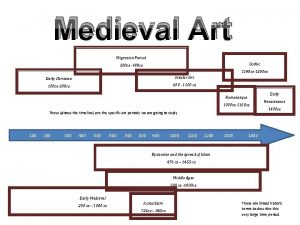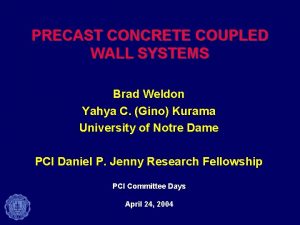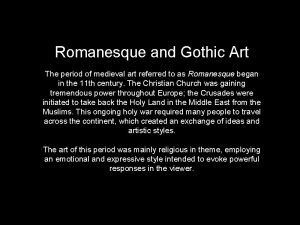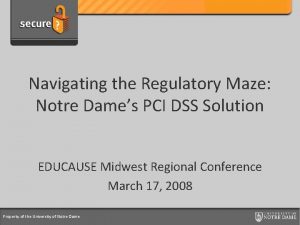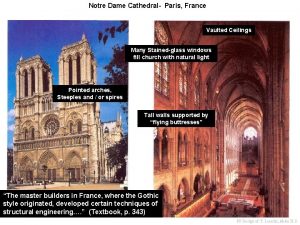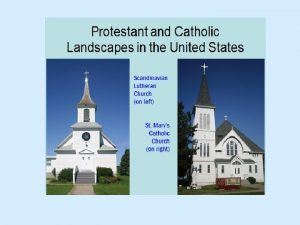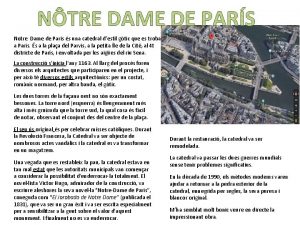Notre Dame de Paris What Does This Mean






















- Slides: 22

Notre Dame de Paris What Does This Mean for Christians?





The History of Cathedrals • The transformation of worship in the 4 th c. • The miraculous to the superstitious • The bravery of martyrs/leaders to the veneration of their memory • From illegal to royal religion • The creation/prestige of Church officers • The movement from simple to complex worship • The need for a place of drama

The History of Cathedrals • The Basilica The architects chose by preference the model of the civic basilicas (dating back to 184 BC), for these had the advantages among others of being the easiest, quickest and most economical of all Public buildings to erect. (Bieler, p. 33) Basilica finished by Constantine in 312 AD)

The History of Cathedrals • The Basilica • A wider space inside • More natural light • Religious creativity Performing the liturgy in such a grand context drew it irresistibly towards formal elaboration. The long naves encouraged processions, and bishops and clergy were vested according to their magisterial dignity. (L&A, Doig, p. 24, 25)

The History of Cathedrals • The Basilica • Old St. Peter’s in Rome, 360 AD • Altar over Peter’s burial spot • First church building built in the shape of a cross

The History of Cathedrals • The Basilica • Outside influences change Christianity The principal characteristics of pagan worship are: 1. A sacred space – shrine, burial, event 2. The notion that worship demands priests. (Bieler, p. 4) • Worship now must have three things: • Sacred space • Sacred leaders • Sacred practices

The History of Cathedrals • The Cathedral • After the 1 st Millennium, theme of the Kingdom of God on earth controlled everything. • The Church had become rich and powerful. • Construction of churches, Abbeys, Monasteries, etc. became a primary source of vision, employment, the trades and arts, and the future growth of civilization in general. • Engineering and architectural advances made more and more elaborate designs possible for competing cities to do more.

The History of Cathedrals • The creation of the “Gothic arch” revolutionized architectural design. • More structural strength • Larger window space • Walls do not need to be so massive

Other innovations: • Ribbed vaulted ceilings to widen interior space • Higher ceilings • Even more room for windows Chartres Cathedral Sainte Chapelle

The Flying Buttress – • Outer walls do not have to be massive • More strength for domed ceilings and spires • Larger and larger spaces for windows • Taller and Wider space inside Amiens Cathedral, Amiens, France


Notre Dame Cathedral • Originally the site of a Gallo-Roman temple • 1 st building – an early Christian basilica, late 4 th c. , dedicated to St. Stephen • Replaced/remodeled in 7 th c. , possibly dedicated to Childebert of the Merovingian dynasty • Cathedral of Saint-Etienne • 1160 – cathedral demolished and building begins • 1345 – construction on present building complete



The History of Cathedrals • The Reformation • The rebuilding of St. Peter’s in Rome created the occasion for Martin Luther’s famous protest.

The History of Cathedrals • The Reformation • The rebuilding of St. Peter’s in Rome created the occasion for Martin Luther’s famous protest. • The arguments/conclusions of the Reformation demonstrated that the millennium-old conclusions about Christianity were wrong: • Sacred space – No! a sacred assembly • Sacred leaders – No! The priesthood of all believers • Sacred practices – No! A solid rejection of the Mass and movement toward a simplified liturgy of worship.

The History of Cathedrals • The Reformation • The rebuilding of St. Peter’s in Rome created the occasion for Martin Luther’s famous protest. • The arguments/conclusions of the Reformation demonstrated that the millennium-old conclusions about Christianity were wrong. • Now, the longest standing witnesses to Christianity • are often abandoned, neglected, “re-used” – relegated to museums • have little to nothing to do with the true gospel • are what most people today associate with Christianity (including the name Notre Dame)

Notre Dame Cathedral • Numerous renovations in 17 th & 18 th c. • Original spire removed in 18 th c. • 1793 – During French Revolution, cathedral rededicated to the “Cult of Reason” and then to the “Cult of the Supreme Reason”, and the Virgin Mary replaced with the “Goddess of Liberty”. • 1801 – Napoleon Bonaparte restored the Cathedral to the Catholic Church. • 1831 – The Hunchback of Notre Dame, an operatic style love story, which excites new interest in the deteriorating building. • 1845 – the center spire rebuilt • 1990 s – attempted renovations proved fruitless requiring further ones slated for the 2010 s.
 Book of kells time period
Book of kells time period Mona lisa golden ratio
Mona lisa golden ratio Notre dame football sponsors
Notre dame football sponsors Notre dame opt
Notre dame opt Notre dame army rotc
Notre dame army rotc Cathdrale
Cathdrale Acct20100
Acct20100 Risk management notre dame
Risk management notre dame Brad weldon notre dame
Brad weldon notre dame Notre dame des sablons
Notre dame des sablons Notre dame oran
Notre dame oran 1300 notre dame
1300 notre dame University of notre dame map
University of notre dame map Chartres cathedral floor plan
Chartres cathedral floor plan Marie vierge sainte que drape le soleil
Marie vierge sainte que drape le soleil Notre dame rotc scholarship
Notre dame rotc scholarship Notre dame des miracles
Notre dame des miracles Notre dame msm program
Notre dame msm program La vierge marie
La vierge marie Vpn notre dame
Vpn notre dame College notre dame des soeurs antonines
College notre dame des soeurs antonines Ron kraemer notre dame
Ron kraemer notre dame Inside nd sakai
Inside nd sakai
